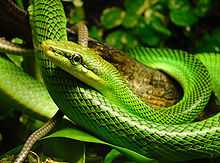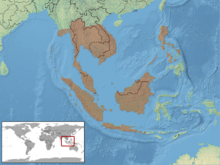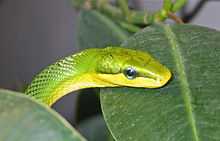Gonyosoma oxycephalum
| Red-tailed green ratsnake | |
|---|---|
 | |
| Red-tailed green ratsnake | |
| Conservation status | |
| Scientific classification | |
| Kingdom: | Animalia |
| Phylum: | Chordata |
| Class: | Reptilia |
| Order: | Squamata |
| Suborder: | Serpentes |
| Family: | Colubridae |
| Genus: | Gonyosoma |
| Species: | G. oxycephalum |
| Binomial name | |
| Gonyosoma oxycephalum (F. Boie, 1827)[2] | |
 | |
| Synonyms | |
|
Elaphe oxycephala (Boie, 1827) | |
The red-tailed green ratsnake (Gonyosoma oxycephalum, also known as arboreal ratsnake and red-tailed racer) is a species of snake found in Southeast Asia.
Description

It is a robust snake with powerful, smooth scales on its belly that is ideal for climbing trees and across branches. It has smaller, smooth scales on its back that is usually bright green or light green and may have black net-like pattern. A gray-colored morph with a yellow head exists in Panay, in the Philippines.
As its name indicates, the snake has a green body with a red tail but is usually brown. It also has a dark line horizontally across its eye. On the sides of its black tongue there may be a Brown and blue colorr. The top of the head maybe dark green, yellow-green or yellow in color.
The female can reach a length of up to 2.4 m (almost 8 feet), while the male is generally a little bit smaller but brighter in coloration. Its average life span in captivity is 20 years. It reaches sexually maturity at 4 years of age, and its eggs have a hatching time from 13 to 16 weeks. The female lays on average between 3 and 8 eggs usually between September and January and the hatchlings are about 45 cm (18 inches) long.
Behavior
The red-tailed green ratsnake lives and spends its life in the trees and in cavities in trees. It seldom descends to the ground. When the snake is stressed, it may inflate a bag of air in its neck, making it appear larger in size.
In captivity, it has quite the 'attitude' and may strike at or bite an unwary handler. Very unpredictable and may change from time to time but may become tame thru proper handling.
Diet
It feeds almost exclusively on birds, bird eggs and bats. It catches them in mid-air while hanging amongst branches. In captivity, it can be trained to feed on rodents such as mice and rats.
Distribution
- Indonesia (Bangka, Belitung, Java, Kalimantan/Borneo, Karimata, Legundi, Lombok, Mentawai islands, Natuna islands, Nias, Panaitan, Riau archipelago, Sebuku, Sumatra, Tambelan archipelago),
- Malaysia (Malaya and East Malaysia, Pulau Tioman ?),
- Singapore Island, Penang Island,
- India (Andaman Islands),
- Myanmar (= Burma),
- Thailand (incl. Phuket), Cambodia, Laos, Vietnam,
- Philippine Islands (Balabac, Bohol, Lubang, Luzon, Negros, Palawan, Sulu Archipelago, Panay)
Type locality Indonesia: Java (Boie, 1827)
References
- ↑ Wogan, G., Vogel, G., Thy, N., Nguyen, T.Q., Demegillo, A., Diesmos, A.C. & Gonzalez, J.C. (2012). "Gonyosoma oxycephalum". IUCN Red List of Threatened Species. Version 2012.2. International Union for Conservation of Nature. Retrieved 20 May 2013.
- ↑ Boie, F. 1827 Bemerkungen über Merrem's Versuch eines Systems der Amphibien, 1. Lieferung: Ophidier. Isis van Oken, Jena, 20: 508-566
- Boulenger,G.A. 1894 On the herpetological fauna of Palawan and Balabac. Ann. Mag. Nat. Hist. (6) 14: 81-90
- Dowling, Herndon G. 1958 A taxonomic study of the ratsnakes VI. Validation of the genera Gonyosoma Wagler and Elaphe Fitzinger. Copeia 1958 (1): 29-40
- Gray, J. E. 1849 Description of three new genera and species of snakes. Ann. Mag. Nat. Hist. (2) 4: 246-248
External links
- Gonyosoma oxycephalum at the Reptarium.cz Reptile Database. Accessed 9 November 2010.
- Video Gonysoma oxycephalum drinking
- Gonysoma oxycephalum Information sheet
